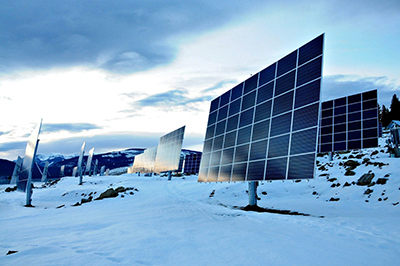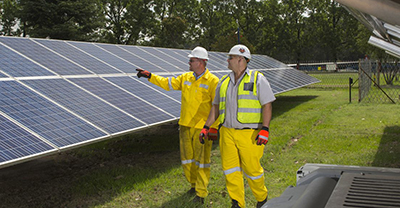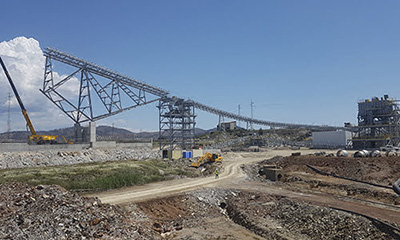Mines Need Not Be Connected To A Traditional Grid Anymore To Power Up.
By J. Weiss
 Every mine needs some amount of power, even if those reasons differ from one to another. Processing, no matter what the commodity, is responsible for a sizeable amount of a mine’s energy consumption, as does keeping all of its technological elements running.
Every mine needs some amount of power, even if those reasons differ from one to another. Processing, no matter what the commodity, is responsible for a sizeable amount of a mine’s energy consumption, as does keeping all of its technological elements running.
Many of the world’s mining operations are getting further and further away from the potential (and need) for grid power. Others are choosing to power on renewables. On a global scale, there is a movement to alternative energy options for a number of reasons – proximity and environmental responsibility arguably being the top motivations.
So, as these options gain popularity in the U.S., what can we learn about the experiences of other operations worldwide? What alternative avenues do North American operations have?
Options and Impetus
Before those questions can be answered, it is important to identify what options are available, and for what end uses. AngloAmerican, as part of its FutureSmart Mining series, offered a comprehensive rundown.
No longer do mines have a limited view when it comes to mine power, especially since renewable energy has become an affordable choice for mines in many regions. The most popular are wind, solar, biodiesel, geothermal energy, hydropower and hydrogen/fuel cell energy; even nuclear energy has as of late seen an uptick in interest, as have hybrid systems. Natural gas is even seeing its day in some places.
It is not only location that deems what is best for a mine, either, as one driving force has been the industry’s search for an alternative that offers lower greenhouse gas (GHG) emissions. Versus a traditional generator or utility link, renewable technology is now less expensive in some cases, offer greater efficiency and can support sustainable development long-term.
From an environmental standpoint, a power alternative like solar instantly lowers environmental risks such as harmful wastes and water pollution. It is also one of the most sustainable, producing concentrated solar power (CSP) or photovoltaic power (PV) for an operation as long as it is needed.
Anglo also pointed out that wind energy has gained interest; in fact, it cited data from the World Wind Energy Association that revealed installations in 2018 totaled 597 gigawatts (GW). Alternative options also have played a part in mines’ efforts to conserve water use.
Finally, renewable energy options in particular help operational sites to use their technologies more effectively. For example, some mines have brought in electric vehicles with their systems, others have implemented cutting-edge artificial intelligence and microgrids. Hydraulic mining is more effectively used as well with green energy technologies, the miner said, as can a site’s bladeless wind turbines.
A Look at the New Energy Landscape
 This past February, Barrick Gold joined with Newmont in a bid to reduce its coal use at the pair’s Nevada mining venture. To do that, it gave the green-light to the conversion of a coal-fired power plant at the complex to one that could also produce natural gas power.
This past February, Barrick Gold joined with Newmont in a bid to reduce its coal use at the pair’s Nevada mining venture. To do that, it gave the green-light to the conversion of a coal-fired power plant at the complex to one that could also produce natural gas power.
Construction on that converted facility was to begin near the end of this year, with plant commissioning in the second quarter of 2022.
It also told various media outlets at the time that it was looking at a potential 200-megawatt (MW) solar facility with battery storage which could begin producing power that same year.
Barrick owns 61.5% of NGV, and Newmont holds the balance. The former is also operator of the project.
Teck, another North American mining company – on a GHG reduction path since 2011 – made it official in January that it had purchased the SunMine solar energy facility in Kimberley, British Columbia, Canada, from its host city.
Formerly the home of Teck’s Sullivan mine site, SunMine placed its panels on land that has now been fully reclaimed. When the mine was in operation, it produced zinc, silver and lead for almost 100 years.
SunMine first became operational in 2015 and now the grid-connected solar facility provides 1.05 MW. It also has the distinction of being the first facility built on the reclaimed mine space, property which Teck offered at the beginning of their partnership along with site infrastructure and development help.
“Our involvement with SunMine is part of our commitment to taking action on climate change, advancing renewable energy development, and supporting the global transition to a low-carbon economy,” Teck CEO and President Don Lindsay said earlier this year.
“SunMine will help us gain firsthand experience with solar power generation as we advance the use of solar power at other operations.”
Teck has more recently taken its energy commitment internationally, confirming in September that it and AES Chile affiliates Compañía Minera Teck Carmen de Andacollo (CdA) and AES Gener inked a long-term power purchase agreement (PPA) that would give 100% renewable power to the company’s Carmen de Andacollo complex in Chile.
Under the deal’s terms, AES Gener will provide from its portfolio of wind, solar and hydroelectric energy 72 MW to CdA. The transition from fossil fuel power sources, Teck said, would remove greenhouse gas emissions totaling 200,000 metric tpy.
“This agreement takes Teck a step closer to achieving our sustainability goals, while also ensuring a reliable, long-term clean power supply for CdA at a reduced cost to Teck,” Lindsay said.
Teck’s Sustainability Strategy includes a goal for the miner to be carbon-neutral by 2050. Along the way, it has committed to milestone goals: 100% of all power needs in Chile will be via renewable power by 2030 and reducing the carbon intensity at its operations by one-third by 2030.
The PPA for Carmen de Andacollo will be in place though the end of 2031.
Carmen de Andacollo is an open-pit copper mine located in the Coquimbo Region of central Chile, around 350 km north of Santiago. Teck owns a 90% interest in the mine, with Empresa Nacional de Minería holding the remaining 10%. It produced 54,000 t of copper in 2019.
Moving now to Spain, Atalaya Mining said in September that it is now in the permitting process for a 50-MW solar plant for its Proyecto Riotinto copper mine in Andalucia.
The capacity will be entirely used for self-consumption at the project, taking advantage of the area’s natural abundance of sunlight. Officials said it has already been named economically viable and could have a positive potential contribution to Proyecto Riotinto’s operating costs.
“The decision to pursue the solar project is in line with Atalaya’s ongoing commitment to environmental sustainability and to continue to have a positive impact on the people, environment and society surrounding the mine,” CEO Alberto Lavendeira said. “This is only a first step in achieving our long-term sustainability goals, but one that will have a positive and near term impact on Proyecto Riotinto.”
 Clearing the Way for Mines’ Success
Clearing the Way for Mines’ Success
As the interest in alternative power options continues to grow for the mining industry, there is also a growth in suppliers hoping to assist with those plans. Many of them are internationally-based but are making their way to the North American mining community quickly.
One is Verditek Solar, which has developed a mine-scale solar power grid that offers clean energy “out of a box” that can be deployed anywhere.
The company can rapidly place solar modules of 125 and 250 kilowatts (kW) that are shipped to sites in special containers and is scalable as an operation grows.
“Adoption of gas-turbines and hybrid wind-solar solutions are increasingly being deployed on the largest new mining projects, but the mainstay of power generation remains diesel,” Verditek said. “Solar has long been considered a potential solution to off-grid power requirements but has struggled with the inherent short comings of fragility, inflexibility, weight and maintenance … until now.”
As the company explained, the industry is on a mission and under pressure to go “green,” thus its response with panels that measure less than 3-mm thick and less than 3 kg per sq. meter while offering the same harvesting capacity as a conventional solar plant. Flexible and rugged, the panels have a durability that is not found on glass panels and those with aluminum frames.
Put into perspective, Verditek’s panels are as much as 10 times lighter than a conventional one and can be installed simply and quickly right into the ground.
As the company consciously works on its growth, Verditek confirmed in September that it had received its first order from the Australian mining industry, a contract that will see its PowerMat solar solution at Intergroup Mining.
Verditek’s PowerMats will bring solar power to InterGroup’s exploration operations based in Queensland, which is going to be outfitted with 75 kW at its camp. The miner said it will be boosting its power needs in the coming year, which could mean future orders for the supplier.
The panels will be used as an element of a diesel-solar hybrid system, with hopes the units will significantly reduce the site’s liquid fuel consumption.
The PowerMats should be shipped to the customer in December.
“As we expand our operations significantly, we have been looking for a cost-effective way to adopt green technology that will move us towards our aim of being a leader in ecologically-friendly gold production,” Steve White, managing director of InterGroup, said.
“Given our projected power demands as we ramp up our mine development, we believe there is scope to increase our take-up for Verditek PowerMat to between 1.5-2 megawatts over the next 12 months.”
Challenges Ahead?
 There are a few obstacles that could slow the progression of renewables and other alternative energy avenues for mines. These are not only North American hindrances, they impact the global industry, but according to financial advisor EY they could certainly keep the transformations at bay.
There are a few obstacles that could slow the progression of renewables and other alternative energy avenues for mines. These are not only North American hindrances, they impact the global industry, but according to financial advisor EY they could certainly keep the transformations at bay.
According to its report “Mining: the growing role of renewable energy,” the firm said the mining sector is indeed driven by energy security concerns, energy price volatility and a shift to a resource-efficient, low carbon economy.
However, “these are critical times for the mining industry,” the researchers of the EY report said. “The scale and pace of renewable energy deployment across the sector is slower than the business case warrants.”
The reasons, the company said, are four-fold: not utilizing third parties for the development; funding and delivering of renewable assets; limited over-arching divisional or regional energy strategy; and a lack of a clear strategic view to the approaches of developers of renewable energy.
Additionally, many see renewables as “non-core” with a significant cost for the opportunity. Will those opinions continue, or will the North American mining sector kick its alternative energy interests into high gear?
J. Weiss is a technical writer and editor covering the eastern United States.
